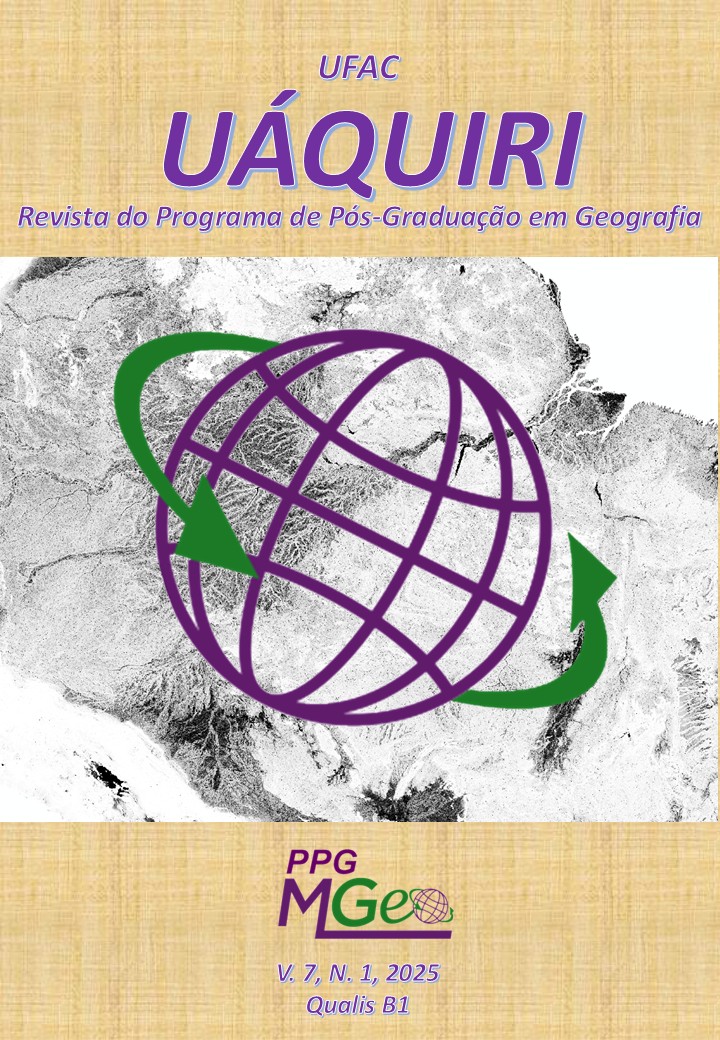ANÁLISE ESPACIAL DE PAISAGENS TÉRMICAS E ILHAS DE CALOR NO MUNICÍPIO DE RIO BRANCO UTILIZANDO IMAGENS DO SATÉLITE LANDSAT-8 SENSOR TIRS (2015-2020)
Keywords:
sensoriamento remoto térmico, temperatura de superfície terrestre, Landsat-8 OLI/TIRS, Ilhas de calor, Planejamento urbanoAbstract
This study explores the application of remote sensing to assess environmental changes and identify heat islands in urban areas, highlighting the importance of this tool in urban planning. The main objective was to use thermal data from the Landsat-8 OLI/TIRS satellite to analyze vegetation and land cover in Rio Branco, AC, and identify areas with heat islands. Images from 2015 and 2020 were used, which were calibrated and corrected using the Split-Window algorithm. The classification of land use and land cover was performed using the Support Vector Machine method. The results showed that the highest surface temperatures (TST) were recorded in densely populated urban areas, especially in the central areas of the city and the First District, as well as in degraded areas, which presented temperatures above 40 °C at 10 AM local time. The NDVI vegetation index showed a negative correlation with TST, indicating that areas with greater vegetation cover tend to have lower temperatures. The NDBI index showed a positive and strong correlation with TST, associating higher urbanization with higher temperatures. The MNDWI index also showed a negative correlation with TST, suggesting that the presence of water helps reduce temperatures. It was concluded that thermal remote sensing is an essential tool for temperature studies in urban areas, allowing the identification of heat islands. The results found will be of great importance to support urban planning, helping to define strategies to mitigate the effects of heat islands and improve thermal comfort in cities.
Downloads
References
Adelabu, S. et al. Exploiting machine learning algorithms for tree species classification in a semiarid woodland using RapidEye image. Journal of Applied Remote Sensing. 2013, v. 7.
Balew, A.; Korme, T. Monitoring land surface temperature in Bahir Dar city and its surrounding using Landsat images. The Egyptian Journal of Remote Sensing and Space Sciences. 2020, v. 23, p. 371-386. https://doi.org/10.1016/j.ejrs.2020.02.001.
Bonfanti, D. C.; Morais, M. De J. Planejamento e expansão da cidade de Rio Branco – AC. Grupo PET Geografia da UFAC: 10 anos de trajetória e contribuições. Org. José Alves, Karina Furini da Ponte, Maria de Jesus Morais. Rio Branco: EDUFAC, 2022.
Bowler, D. E. et al. Urban greening to cool towns and cities: A systematic review of the empirical evidence. Landscape and Urban Planning. 2010, v. 97, p. 144-155.
Brinkman, W.L.F.; Ribeiro, M.N.G. Air temperatures in Central Amazônia. III Vertical temperature distribution on a clearcut area and in a secondary forest near Manaus (cold front conditions July 10th, 1969). Acta Amazônica. 1972, v. 2, p. 25-29.
Cai, G.; Du, M.; Xue, Y. Monitoring of urban heat island effect in Beijing combining ASTER and TM data. Int. Journal Remote Sens. 2011, v. 32, p. 1213-1232. https://doi.org/10.1080/01431160903469079.
Cai, Y.; Chen, Y.; Tong, C. Spatiotemporal evolution of urban green space and its impact on the urban thermal environment based on remote sensing data: A case study of Fhuzou City, China. Urban Forestry and Urban Greening. 2019, v. 41, p. 333-343. https://doi.org/10.1016/j.ufug.2019.04.012.
Chang, C.R.; Li, M.H.; Chand, S.D. A preliminary study on the local cool island intensity of Taipei city parks. Landscape and Urban Planning. 2007, v. 80, p. 386-395. https://doi.org/10.1016/j.landurbplan.2006.09.005.
Chapra, S.C. Surface water-quality modeling. New York: N.Y. McGraw-Hill, 1997.
Chavez, P. S. Image-based atmospheric corrections revisited and improved. Photogrammetric Eng. Remote Sens. 1996, v. 62, p.1025-1036.
Chen, X.L. et al. Remote sensing image-based analysis of the relationship between urban heat island and land use/cover changes. Remote Sens. Environ. 2006, v. 104, p. 133-146. https://doi.org/10.1016/j.rse.2005.11.016.
Climate-Data.Org. Clima Rio Branco. Avaliable online: https://pt.climate-data.org/america-do-sul/brasil/acre/rio-branco-4000/ (Acessed on 09/01/2020).
Clinton, N.; Gong, P. MODIS detected surface urban heat islands and sinks: Global locations and controls. Remote Sens. Environ. 2013, v. 134, p. 294-304. https://doi.org/10.1016/j.rse.2013.03.008.
Cohen, J. A coefficient of agreement for nominal scales. Educational and Psychological Measurement, v. 20, n. 1. 1960. https://doi.org/10.1177/001316446002000104.
Costa, D. F.; Silva, H. R. & Peres, L. F. Identificação de ilhas de calor na área urbana de Ilha Solteira – SP através da utilização de geotecnologias. Revista Engenharia Agrícola. 2010, v. 30, p. 974-985.
De Alcântara, E. H. Sensoriamento remoto da temperatura e dos fluxos de de calor na superfície da água do reservatório de Itumbiara (GO). Tese de Doutorado, Programa de Pós-graduação do INPE em Sensoriamento Remoto, São José dos Campos, São Paulo, 2010.
Delgado, R.C. et al. Influência da mudança da paisagem amazônica no aumento da precipitação em Cruzeiro do Sul, AC. Enciclopédia Biosfera. 2012, v. 8, p. 665-674.
Delgado, R.C.; Daher, M.; Faria, A.L.L. Uso do sensoriamento remoto na estimativa dos efeitos de ilhas de calor. Revista Brasileira de Ciências Ambientais. 2012, n. 25.
Department Of The Interior U.S. Geological Survey (USGS). Landsat 8 (L8) Data Users Handbook. 2019, v. 5.
Duarte, D. H. O impacto da vegetação no microclima em cidades adensadas e seu papel na adaptação aos fenômenos de aquecimento urbano. Contribuições a uma abordagem interdisciplinar. 2015. Tese (Livre – Docência). Departamento de Tecnologia da Arquitetura. São Paulo, 2015.
El-Magd, I.A.; Ismail, A.; Zanaty, N. Spatial variability of urban heat islands in Cairo City, Egypt using time series of Landsat satellite images. International Journal of Advanced Remote Sensing and GIS. 2016, v. 5, p. 1618-1638. https://doi.org/10.23953/cloud.ijarsg.48.
Emmanuel, R. An urban approach to climate-sensitive design. Strategies for the tropics. New York: Spon Press, 2005.
Emmanuel, R. Urban heat islands and sustainable urbanity: An application agenda for tropical mega-cities. City Weathers. 2011, p. 75-80.
European Spatial Agency – ESA. Radiometric Resolution. Avaliable online: https://sentinel.esa.int/web/sentinel/user-guides/sentinel-3-lstr/resolutions/radiometric (Acessed on 04/09/2020).
Givoni, B. Climate considerations in the building and urban desingn. New York: J Wiley & Sons, 1998.
Gosling, S. N., et al. Associations between elevated atmospheric temperature and human mortality: A critical review of the literature. Climatic Change. 2009, v. 92, p. 299-341. https://doi.org/10.1007/s10584-008-9441-x.
Gupta, N.; Manthewm A.; Khandelwal, S. Analysis of cooling effect of water bodies on land surface temperature in nearby region: A case study of Ahmedabad and Chandigarh cities in India. The Egyptian Journal of Remote Sensing and Space Sciences. 2019, v. 22.
Hathway, E.A.; Sharples, S. The interaction of rivers and urban form in mitigating the Urban Heat Island effect: a UK case study. Building and Environment. 2012, v. 58, p. 14-22. https://doi.org/10.1016/j.buildenv,2012.06.013.
Henderson-Sellers, B. Engineering limnology. London: Pitman, 356p. 1984.
Huynen, M. M. et al. The impact of heat waves and cold spells on mortality rates in the Dutch population. Environmental Health Perspectives. 2001, v. 109, p. 463-470. https://doi.org/10.1289/ehp.01109463.
Imhoff, M. L. et al. Remote sensing of the urban heat island effect across biomes in the continental USA. Remote Sensing of Environment. 2010, v. 114, p. 504-513.
Irons, J.R.; Dwyer, J L; Barsi, J.A. The next Landsat satellite: The Landsat data continuity mission. Remote Sens. Environ. 2012, v. 122, p. 11-21. https://doi.org/10.1016/j.rse.2011.08.026.
Jensen, J. R., 2004. Introductory digital image processing: A remote sensing perspective, 3rd edition (NJ: Prentice Hall Logicon Geodynamics, Inc).
Jia, K. et al. Land cover classification using Landsat 8 Operational Land Imager data in Beijing, China. Geocarto International. 2014, v. 29, p. 941-951. https://doi.org/10.1080/10106049.2014.894586.
Leite, A.C. de. S. et al. Mudança espaço temporal do uso e cobertura do solo e estimativa da temperatura de superfície no município de Teresina – Piauí, Brasil. Anuário do 58 Instituto de Geociências – UFRJ. 2019, v. 42, p. 42-51. http://dx.doi.org/10.11137/2019_3_42_51.
Liu, J. et al. Predicting the surface urban heat island intensity of future urban green space development using a multi-scenario simulation. Sustainable Cities and Society. 2021, v. 66. https://doi.org/10.1016/j.scs.2020.102698.
Liu, L.; Zhang, Y. Urban Heat Island analysis using the Landsat TM data and ASTER data: A case study in Hong Kong. Remote Sensing. 2011, v. 3, p. 1535-1552. https://doi. org/10.3390/rs3071535.
Marengo, J.; Nobre, C.A. Climatic impacts of “Friagens” in forested and deforested areas of the Amazon Basin. Journal of Applied Metereology. 1997, v. 36, p. 1553-1566.
McHugh, M. L. Interrater reliability: the kappa statistic. Beochimia Medica, v. 22, n. 3. 2012.
Mcmillin, L.M. Estimation of sea surface temperatures from two infrared window measurements with different absorption. Journal of Geophysiscal Research. 1975, v. 80, p. 5113-5117. https://doi.org/10.1029/JC080i036p05113.
Neog, R. Evaluation of temporal dynamics of land use and land surface temperature (LST) ir Agartala city of India. Enivonm. Develop. and Sustainability. 2022, v. 24, p. 3419-3438.
Oke, T. R. et al. Urban Climates. Cambridge: Cambridge University Press. 2017.
Quattrochi, D.A.; Luvall, J.C. Thermal infrared remote sensing for analysis of landscape ecological processes: Methods and applications. Lands. Ecology. 1999, v. 14, p. 577-598.
Rizwan, A.M.; Dennis, Y.C.L.; Liu, C.H. A review on the generation, determination and mitigation of Urban Heat Island. Journal of Environmental Sciences. 2008, v. 20, p. 120-128. https://doi.org/10.1016/S1001-0742(08)60019-4.
Roy, S. et al. Examining the nexus between land surface temperature and urban growth in Chattogram Metropolitan Area of Bangladesh using long term Landsat series data. Urban Climate. 2020, v. 32. https://doi.org/10.1016/j.uclim.2020.100593.
Sayão, V.M. et al. Land use/ land cover changes and bare soil surface temperature monitoring in southes Brazil. Geoderma Regional. 2020, n. 22. https://doi.org/10.1016/j.geodrs.2020.e00313.
Schwarz, N.; Lautenbach, S.; Seppelt, R. Exploring indicators for quantifying surface urban heat islands of European cities with modis land surface temperatures. Remote Sens. Environ. 2011, v. 115, p. 3175-3186. https://doi.org/10.1016/j.rse.2011.07.003.
Shahfahad et al. Longitudinal study of land surface temperature (LST) using mono and split-window algorithms and its relationship with NDVI and NDBI over selected metro cities of India. Arabian Journal of Sciences. 2020, v. 13. https://doi.org/10.1007/s12517-020-06068-1.
Shimabukuro, Y. E; Ponzoni, F. J. Spectral Mixing: Model and linear applications. São Paulo – SP: Oficina de Textos, 2017.
Silva, A. G. L.; Torres, M. C. A. Proposing an effective and inexpensive tool to detect urban surface temperature changes associated with urbanization processes in small cities. Building and Environment. 2021, v. 192. https://doi.org/10.1016/j.buildenv.2021.107634.
Sobrino, J. A.; Jimenez-Munoz, J. C., Paolini, L. Land surface temperature retrieval from Landsat TM 5. Remote Sens. Environ. 2004, v. 90, p.434-440. https://doi.org/10.1016/j.rse.2004.02.003.
Sobrino, J. A.; Raissouni, N.; Li, Z. L. A comparative study of land surface emissivity retrieval from NOAA data. Remote Sens. Environ. 2001, v. 75, p.256-266. https://doi.org/10.1016/S0034-4257(00)00171-1.
Sobrino, J.A. et al. Single-channel and two-channel methods for land surface temperature retrieval from DAIS data and its application to the Barrax site. Int. Journal Remote Sens. 2004, v.25, p.215-230.
Stathopoulou, M.; Cartalis, C. Daytime urban heat islands from Landsat ETM+ and corine land cover data: an application to major cities in Greece. Solar Energy. 2007, v. 81, p. 358-368. https://doi.org/10.1016/j.solener.2006.06.014.
Stewart, I. D.; Oke, T. R. Local Climate Zones for urban temperature studies. Bulletin of the American Metereology Society. 2012, v. 93, p. 1879-1900.
Su, W.; Gu, C.; Yang, G. Assessing the impact of land use/land cover on urban heat island pattern in Nanjin City, China. Journal Urban Plann. Develop. 2010, v. 136, p. 365-372.
Sun, Q.; Wu, Z.; Tan, J. The relationship between land surface temperature and land use/land cover in Guangzhou, China. Environ. Earth Sci. 2012, v. 65, p. 1687-1694.
Sun, R. Et al. Cooling effects of wetlands in an urban region: the case of Beijing. Ecological Indicators. 2012, v. 20, p. 57-64. https://doi.org-10.1016/j.ecolind.2012.02.006.
Taha, H. Urban Climate and heat islands: albedo, evapotranspiration and anthropogenic heat. Energy and Buildings. 1997, v. 25, p. 99-103.
Tan, J. et al. The urban heat island and its impact on heat wares and human health in Shanghai. Int. J. Biometeorol. 2010, v. 54, p. 75-84,
Tomlinson, C. J et al. Including the urban heat island in spatial heat health risk assessment strategies: A case study for Birmingham, UK. International Journal of Health Geographics. 2011, v. 10.
Tu, L. et al. Surface urban heat island effect and its relationship with urban expansion in Nanjing, China. Journal of Applied Remote Sensing. 2016, v. 10, p. 026-037. https://doi.org/10.1117/1.JRS.10.026037.
United States Geological Survey - USGS. USGS EROS Archive – Advanced Very High Resolution Radiometer – AVHRR. Avaliable online: https://www.usgs.gov/centers/eros/science/usgs-eros-archive-advanced-very-high-resolution-radiometer-avhrr (Acessed on 04/09/2020).
Wang, F. et al. An improved monowindow algorithm for land surface temperature retrieval from Landsat 8 thermal infrared sensor data. Remote Sens. 2015, v. 7, p. 4268-4289. https://doi.org/10.3390/rs70404268.
Wang, L.; Lu, Y.; Yao, Y. Comparison of Three Algorithms for the Retrieval of Land Surface Temperature from Landsat 8 Images. Sensors. 2019, v. 19, p. 504. https://doi:10.3390/s19225049.
Weng, Q. Thermal infrared remote sensing for urban climate and environmental studies: Methods, applications, and trends. Journal of Photogrammetry and Remote Sensing. 2009, v. 64, p. 335-344. https://doi.org/10.1016/j.isprsjprs.2009.03.007.
Wetzel, R.G. Limnology: lake and river ecosystems. 3. Ed. San Diego: Academic Press, 2001.
Wu, X.; Zhang, L.; Zang, S. Examining seasonal effect of urban heat island in a coastal city. PLoS ONE. 2019, v. 14. https://doi.org/10.1371/journal.pone.0217850.
Yue, W.; Xu, J.; Tan, W. The relationship betweend land surface temperature and NDVI with remote sensing: application to Shanghai Landsat 7 ETM+ data. International Journal of Remote Sensing. 2007, v. 28, p. 3205-3226. https://doi.org/10.1080/01431160500306906.
Zhang, Y. et al. Land surface temperature retrieval from CBERS-02 IRMSS thermal infrared data and its applications in quantitative analysis of urban heat island effect. Journal of Remote Sensing. 2006, v. 10, p. 789-797.










